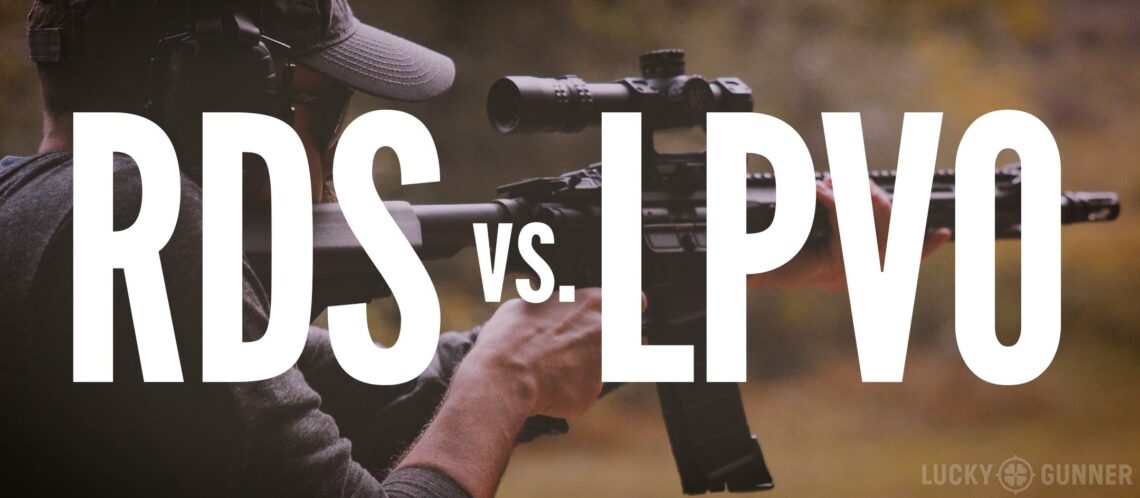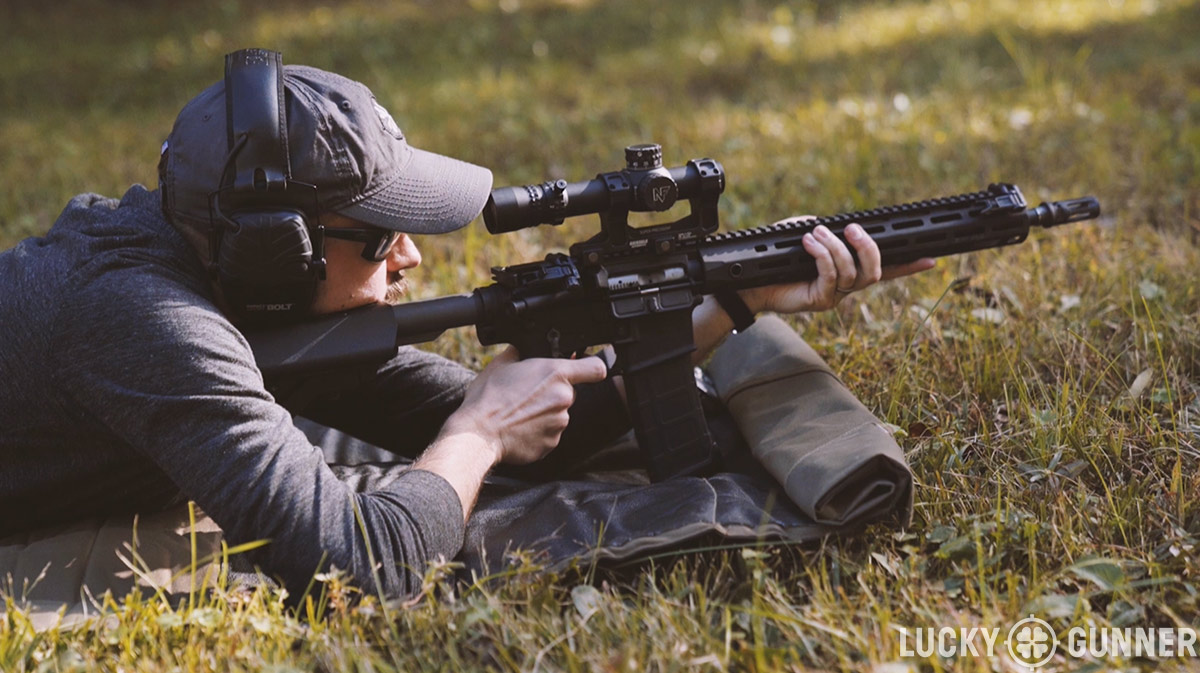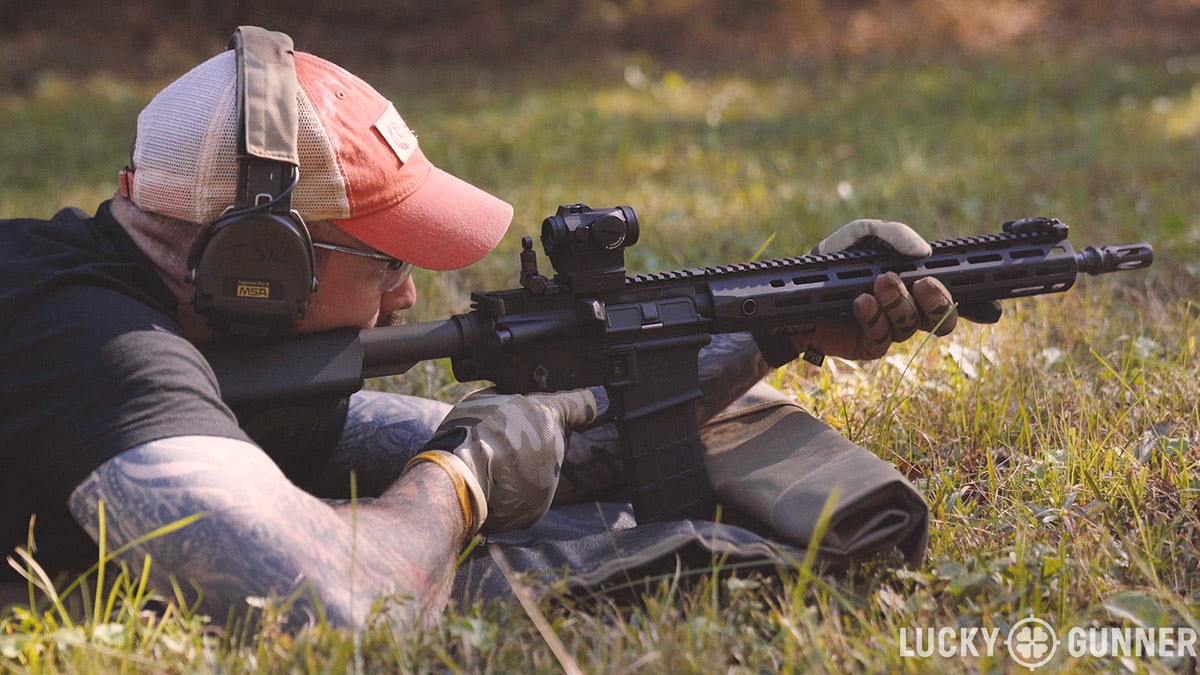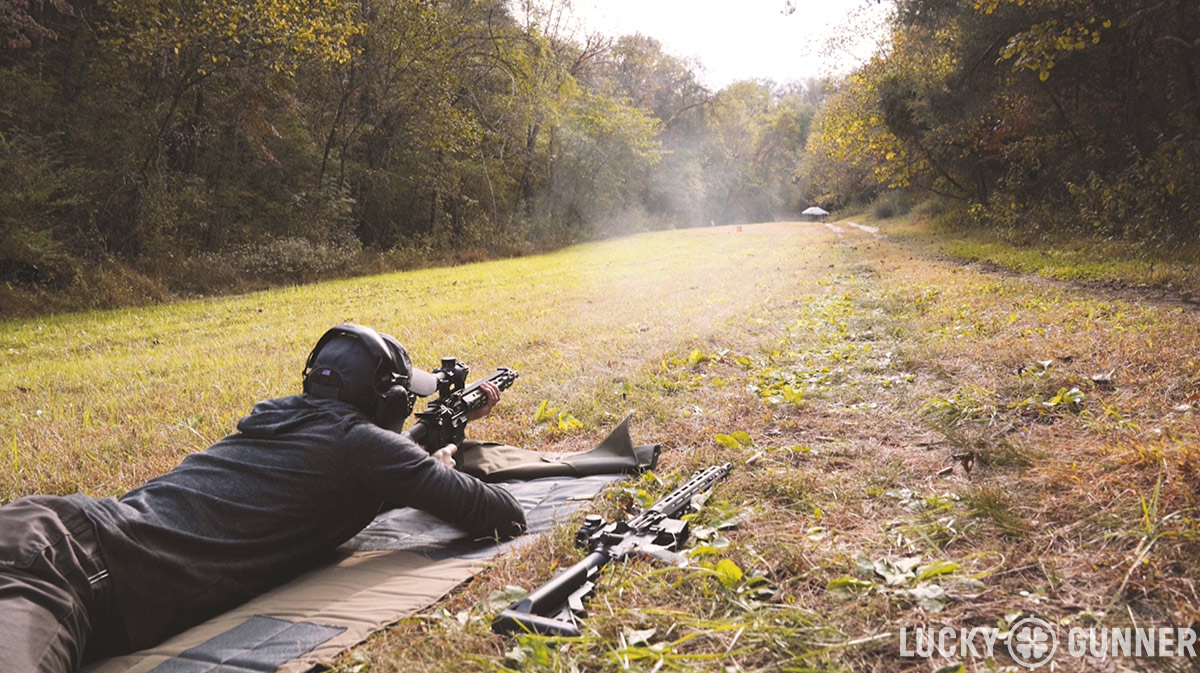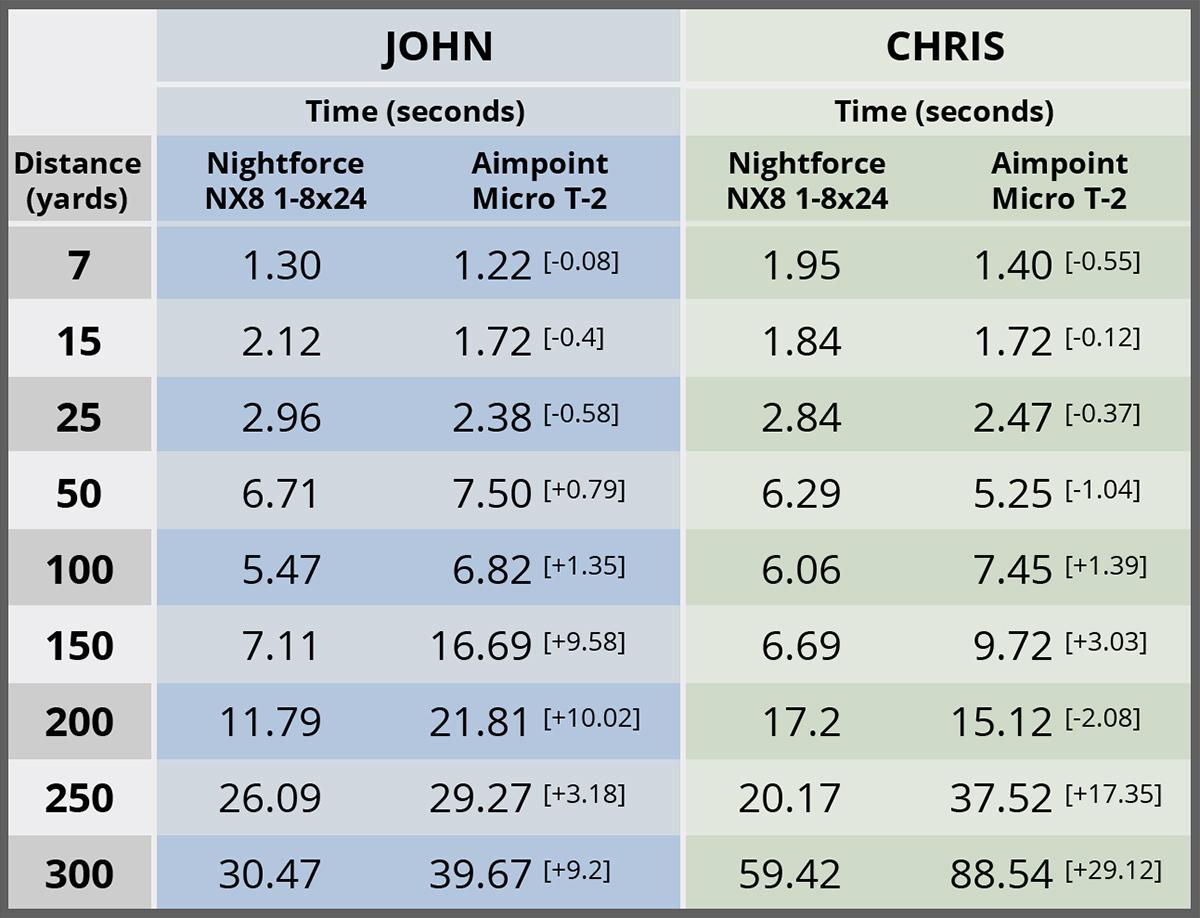Over the last few years, there have been some huge strides in the low power variable optics (LPVO) market, both in terms of quality and availability. Some instructors and other industry leaders have even suggested that cost is the only thing preventing LPVOs from completely replacing non-magnified red dot sights as the go-to option for defensive/fighting carbines. Budget-level and mid-tier LPVOs are getting better and cheaper, but are still usually lacking in visual clarity at 1x when compared to a top-shelf red dot like an Aimpoint. But how about a premium LPVO like the Nightforce NX8 1-8x24mm scope? Does it compete with an Aimpoint at close range? And at what distance does the lack of magnification in the Aimpoint give the LPVO a clear advantage? That’s what John Johnston and I set out to discover in this episode of “Stuff John and Chris Wanna Know.” We didn’t actually get the definitive answer we were hoping for, but I think we came away with some useful impressions.
Details are in the video below, or scroll on down to read the full transcript. If you’d like to see the raw data from the drill we ran for this video, you can find that at the bottom of this page below the transcript.
CHRIS: Hey guys, Chris here from Lucky Gunner with John Johnston from Citizen’s Defense Research. We’re doing another… Things We Kinda Wanna Know.
JOHN: We can’t decide… what are we calling this?
CHRIS: Whatever it’s called. The graphic that says the name of the show! [Stuff John and Chris Wanna Know] So what do we want to know this time, John?
JOHN: What we want to know is whether or not there’s any measurable advantage between a low power variable optic (LPVO) and a red dot sight (RDS). So we found some of the best [optics] we could find. We started with a Nightforce NX8 which is a 1-8x and then we did an Aimpoint T-2 and we put them on Knights Armament SR-15s. So, the top teir stuff. We were trying to remove as many equipment variables–
CHRIS: Two identical rifles except for the optic.
JOHN: Yeah, everything was the same.
CHRIS: Right, Aimpoints and other red dots have kind of been the go-to optics for the last several years but then more recently, the low power variable scopes have been the “new hotness.” The idea is that if you dial that all the way down to 1x, which is supposedly a true 1x so it looks more or less like the red dot at 1x…
JOHN: Right, with a daylight illuminated reticle.
CHRIS: Right, so you get the same advantage as a red dot except you can dial it up and get magnification. So we wanted to know at what point does the Aimpoint stop being what you want and there’s more of an advantage from that magnification.
JOHN: Yeah, and the awesome thing about doing this video is we didn’t answer that question even a little bit.
CHRIS: Right! But we did learn some things.
JOHN: Yes.
CHRIS: And we maybe came up with some questions that we could explore later on.
JOHN: Right, so what we did is we started from low ready when we were standing then when we went to prone we started with the butt of the rifle rested [on the ground] and up on our elbows. It was just three hits to an 8-inch circle.
CHRIS: So we timed it, and as long as it took to get three hits, that was our time for that run.
JOHN: Right, and we did that at 7, 15, 25, 50, 100, 150, 200, 250, and 300.
CHRIS: And we did it standing up to 50 and then we started going prone at 100.
JOHN: Right. And it was… not easy.
CHRIS: No.
JOHN: I actually regret most of my life decisions, but specifically the 8-inch circle.
CHRIS: Right, the 8-inch circle was a bit ambitious.
JOHN: Ambitious! Yes! That is the word I was looking for.
CHRIS: Especially considering neither of us have time behind these rifles. It’s all new to us as far as the little idiosyncrasies that make a big difference when you’re shooting at 300 yards. The stock, the trigger, the mounts, all that stuff.
JOHN: And the other thing is that we possibly… were not using the same ammo for all of it.
CHRIS: Right, we just kind of used whatever 5.56 we had laying around. So this is definitely not scientific.
JOHN: No, this is just Stuff John and Chris Wanna Know!
CHRIS: Right, it’s stuff we wanna know. And I think — and this might actually have been good — we had some issues with sunlight. It wasn’t fun, but I think it introduced some variables we weren’t counting on and we learned a couple of things.
JOHN: Yeah, so people talk about “photonic barriers” and the fact that light can restrict your vision and stuff like that. Most of the time when people talk about that, at least when I hear people talk about that, they’re talking about at night with flashlights and stuff. But when you’re at 200 yards or 300 yards, or even 100 yards and the sun is directly in front of you and you’ve got a target that’s in the shade and stuff like that and smoke in the air… it was kind of a big deal. So I know what everyone is going to ask, “Which one should I buy?” Because that’s what people do, right?
CHRIS: Context has so much to do with it.
JOHN: Right, so here’s what I’ll say. If I were in a position or profession where I needed to identify stuff at distance, especially when it was in the middle of other stuff, before I launched a round into it, I would absolutely say that having a magnified optic is important.
CHRIS: I think that’s totally fair to say.
JOHN: If, on the other hand, you’re a private citizen who is interested in home defense, or even property defense, if you’ve got a “regular-sized” property, the red dot is probably fine. Even if you’re like one of the — civil unrest like Katrina or something like that, red dot’s probably fine. Probably.
CHRIS: Right, because the red dot is lighter, it’s less expensive, at least as far as — these are two top-tier optics — the Aimpoint is significantly less expensive than the Nightforce.
JOHN: Yeah, about 1000 bucks-ish.
CHRIS: Yeah, so those are the big things for a lot of people. But we also notice when handling these rifles, picking them up, putting them down, the Aimpoint was a lot more pleasant to handle and work with.
JOHN: Yeah, exactly. Now, what capabilities you need? I don’t know, I’m not you. I see use in either one of them. I think it’s probably worth pointing out, neither one of us are “rifle guys.” I think we’re definitely both handgun guys because that is like an everyday thing for us. We’re both shotgun nerds. I’ve got a lot of time with rifles, but I don’t feel any deep burning passion to get better with one.
CHRIS: Right, I feel comfortable with rifles, I like ARs. It’s not my thing. But yeah, like you said, I’m also not a cop or military, but if I did have to roll around with a rifle in my trunk for some kind of exigent circumstance, I would really like it if I had some magnification on there.
JOHN: Probably so. And here’s something else I’ll say, too. We are using top-tier stuff. When you get into lower-tier stuff, when does the price point start to really negatively impact reliability?
CHRIS: And not just reliability, but stuff like —
JOHN: Quality of the glass.
CHRIS: Where you put your eye, the forgiveness of the eye box. I feel like the Nightforce was really good about that. We were doing some pretty awkward positions because the ground is so uneven out here. I never had a problem getting behind that scope and seeing a clear shot to the target, even if I didn’t have great placement of my eye behind the scope.
JOHN: Yeah, and something interesting about that is the mount we were using to put it kind of on par with the Aimpoint as far as height is really suboptimal for shooting from prone. It’s designed for a more upright head position, especially if you’re wearing armor. Yeah, I don’t know… I don’t think we answered our question.
CHRIS: So what’s better, a red dot or a scope? Your favorite answer…
JOHN: It depends.
CHRIS: It depends. And it really does depend on so many different things. Someone might even be thinking, I want — you know, I’ve got one AR, I want to have red dot capability in my home, but I want to go out on the weekend and stretch it out just for fun. Without having to mess with the optic, if you put a high quality low power variable scope on it, you could do all that stuff with just one rifle.
JOHN: Right, and I think that’s kind of — you know, if I had to pick something that was a do-everything answer, I’d go with the low power variable optic. You’d have to. If you’re looking for something that can do everything from zero to 400 (and not zero to 400 on known-distance identified targets but zero to 400 on actual targets), I think that you absolutely gain a huge advantage with the low power variable. If that’s not your jam, though, and you want to save 1000 bucks and have a rifle that handles better — I mean, it just handles better, you can’t say anything different. If you’re saying “it handles just as good!” no, you’re lying.
CHRIS: It’s just not quite the same.
JOHN: No, not even a little bit. Then, yeah, go with the red dot.
CHRIS: So there’s your answer/non-answer to what we wanted to know and next time, we’ll want to know something else.
JOHN: Yeah, we’ll want to know something else and probably not get an answer to that either. I think that’s gonna be the theme of this series.
CHRIS: Yeah, sounds like it.
RDS vs. LPVO Drill Results
Because we were dealing with so many other variables that had nothing to do with the optics we were testing, like the ammo, the uneven terrain, and the constantly changing lighting conditions, I don’t think there’s a lot to learn just from looking at the raw data from our drills. But for those who might be curious, I’ve posted that data in the chart below followed by a few notes. Don’t trust these numbers, though. They will lie to you!
If there’s any big takeaway from this data, it’s that the red dot sight was slightly quicker by tenths of a second for both of us at close range but the LPVO was generally faster by a couple of seconds or more at 100/150 yards and beyond. There were some exceptions, and those are most likely attributable to one of the factors I mentioned previously. The intermittent sunlight shining directly into our eyes/optics was probably the biggest variable. It changed our ability to see the target, regardless of which optic we were using. For example, I had a better time with the Aimpoint at 200 yards, but if given the choice, I would almost always prefer to have magnification at 200 versus a red dot optic.
Between 50 and 200 yards, the Aimpoint slowed John down a bit more than it did me. In addition to the sun issue, I think this is also simply because we have different eyeballs. John has some vision issues that make the Aimpoint harder to use at longer range. If you watch the video, you may notice in a couple of the clips that he has the rear aperture flipped up when using the Aimpoint because it makes the dot appear to be a bit more crisp and easier for him to see. Thanks to medical science, I have more or less perfect 20/20 vision and feel pretty confident with the Aimpoint up to 100 or so (and 200 with larger targets). If you have any kind of vision issues, you will probably get more benefit from an LPVO than someone who does not.
At 250 yards, my time with the Aimpoint went way up, and was drastically higher with both optics at 300. John’s time shot up quite a bit with the LPVO at 250, but I think that was the lighting again. I was really struggling with the terrain at 300 yards. I was prone on an incline with my feet elevated slightly higher than my head and the rifle even farther down the hill. I wasn’t able to get a consistent cheek weld and, despite the forgiving eyebox of both optics, I could not seem to hit anything. John managed to find a slightly more favorable spot to set up at the 300 yard line, but he was still having similar issues. Also, we zeroed the rifles at 100 yards before starting, but were pretty much guessing what our holdovers should be at 300. I was not a good guesser.
